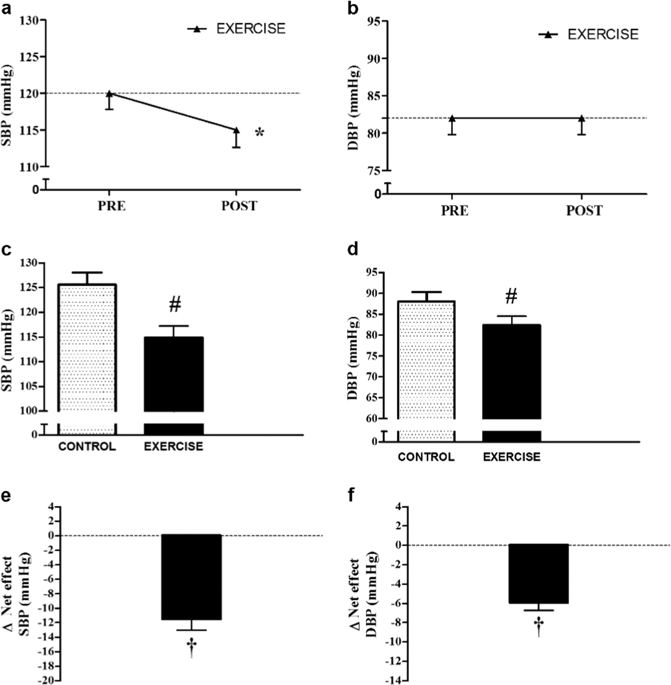当前位置:
X-MOL 学术
›
J. Hum. Hypertens.
›
论文详情
Our official English website, www.x-mol.net, welcomes your
feedback! (Note: you will need to create a separate account there.)
Post-exercise hypotension and its hemodynamic determinants depend on the calculation approach.
Journal of Human Hypertension ( IF 2.7 ) Pub Date : 2020-01-21 , DOI: 10.1038/s41371-020-0297-5 Rafael Yokoyama Fecchio 1 , Leandro Campos de Brito 1 , Tiago Peçanha 2 , Cláudia Lúcia de Moraes Forjaz 1
Journal of Human Hypertension ( IF 2.7 ) Pub Date : 2020-01-21 , DOI: 10.1038/s41371-020-0297-5 Rafael Yokoyama Fecchio 1 , Leandro Campos de Brito 1 , Tiago Peçanha 2 , Cláudia Lúcia de Moraes Forjaz 1
Affiliation

|
Post-exercise hypotension (PEH) has been assessed by three calculation approaches: I = (post-exercise - pre-exercise), II = (post-exercise - post-control), and III = [(post-exercise - pre-exercise) - (post-control - pre-control)]. This study checked whether these calculation approaches influence PEH and its determinants. For that, 30 subjects underwent two exercise (cycling, 45 min, 50% VO2 peak) and two control (seated rest, 45 min) sessions. Systolic (SBP) and diastolic (DBP) blood pressures, cardiac output (CO), systemic vascular resistance (SVR), heart rate (HR), and stroke volume (SV) were measured pre- and post-interventions in each session. The mean value for each moment in each type of session was calculated, and responses to exercise were analyzed with each approach (I, II, and III) to evaluate the occurrence of PEH and its determinants. Systolic PEH was significant when calculated by all approaches (I = -5 ± 1, II = -11 ± 2, and III = -11 ± 2 mmHg, p < 0.05), while diastolic PEH was only significant when calculated by approaches II and III (-6 ± 1 and -6 ± 1 mmHg, respectively, p < 0.05). CO decreased significantly after the exercise when calculated by approach I, but remained unchanged with approaches II and III, while SVR increased significantly with approach I, but decreased significantly with approaches II and III. HR was unchanged after the exercise with approach I, but increased significantly with approaches II and III, while SV decreased significantly with all approaches. Thus, PEH and its hemodynamic determinants are influenced by the calculation approach, which should be considered when designing, analyzing, and comparing PEH studies.
中文翻译:

运动后低血压及其血流动力学决定因素取决于计算方法。
运动后低血压 (PEH) 已通过三种计算方法进行评估:I =(运动后 - 运动前),II =(运动后 - 控制后)和 III = [(运动后 - 运动前 -练习)-(后控制-前控制)]。本研究检查了这些计算方法是否影响 PEH 及其决定因素。为此,30 名受试者接受了两次运动(骑自行车,45 分钟,50% VO2 峰值)和两次控制(坐姿休息,45 分钟)。在每次干预前和干预后测量收缩压 (SBP) 和舒张压 (DBP)、心输出量 (CO)、全身血管阻力 (SVR)、心率 (HR) 和每搏输出量 (SV)。计算每种类型训练中每个时刻的平均值,并使用每种方法(I、II 和 III)分析对运动的反应,以评估 PEH 的发生及其决定因素。当通过所有方法计算时,收缩期 PEH 是显着的(I = -5 ± 1,II = -11 ± 2,和 III = -11 ± 2 mmHg,p < 0.05),而舒张期 PEH 仅在通过方法 II 和III (-6 ± 1 和 -6 ± 1 mmHg, 分别, p < 0.05)。当通过方法 I 计算时,运动后 CO 显着降低,但在方法 II 和 III 中保持不变,而 SVR 在方法 I 中显着增加,但在方法 II 和 III 中显着降低。使用方法 I 锻炼后 HR 没有变化,但使用方法 II 和 III 显着增加,而所有方法的 SV 显着降低。因此,PEH 及其血流动力学决定因素受计算方法的影响,在设计、分析和比较 PEH 研究时应考虑这一点。
更新日期:2020-01-21
中文翻译:

运动后低血压及其血流动力学决定因素取决于计算方法。
运动后低血压 (PEH) 已通过三种计算方法进行评估:I =(运动后 - 运动前),II =(运动后 - 控制后)和 III = [(运动后 - 运动前 -练习)-(后控制-前控制)]。本研究检查了这些计算方法是否影响 PEH 及其决定因素。为此,30 名受试者接受了两次运动(骑自行车,45 分钟,50% VO2 峰值)和两次控制(坐姿休息,45 分钟)。在每次干预前和干预后测量收缩压 (SBP) 和舒张压 (DBP)、心输出量 (CO)、全身血管阻力 (SVR)、心率 (HR) 和每搏输出量 (SV)。计算每种类型训练中每个时刻的平均值,并使用每种方法(I、II 和 III)分析对运动的反应,以评估 PEH 的发生及其决定因素。当通过所有方法计算时,收缩期 PEH 是显着的(I = -5 ± 1,II = -11 ± 2,和 III = -11 ± 2 mmHg,p < 0.05),而舒张期 PEH 仅在通过方法 II 和III (-6 ± 1 和 -6 ± 1 mmHg, 分别, p < 0.05)。当通过方法 I 计算时,运动后 CO 显着降低,但在方法 II 和 III 中保持不变,而 SVR 在方法 I 中显着增加,但在方法 II 和 III 中显着降低。使用方法 I 锻炼后 HR 没有变化,但使用方法 II 和 III 显着增加,而所有方法的 SV 显着降低。因此,PEH 及其血流动力学决定因素受计算方法的影响,在设计、分析和比较 PEH 研究时应考虑这一点。











































 京公网安备 11010802027423号
京公网安备 11010802027423号